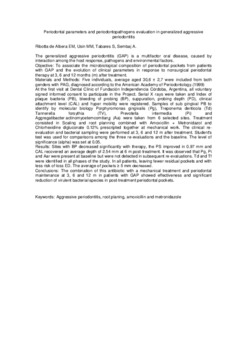Periodontal parameters and periodontopathogens evaluation in generalized aggressive periodontitis

View/
Date
2013Author
Ribotta de Albera, Estela
Usin, María Matilde
Tabares, Sandra
Sembaj, Adela
Metadata
Show full item recordAbstract
Interaction among the host response, pathogens and environmental factors. Objective: To associate the microbiological composition of periodontal pockets from patients with GAP and the evolution of clinical parameters in response to nonsurgical periodontal therapy at 3, 6 and 12 months (m) after treatment. Materials and Methods: Five individuals, average aged 30,6 ± 2,7 were included from both genders with PAG, diagnosed according to the American Academy of Periodontology.(1999) At the first visit at Dental Clinic of Fundación Independencia Córdoba, Argentina, all voluntary signed informed consent to participate in the Project. Serial X rays were taken and Index of plaque bacteria (PB), bleeding of probing (BP), suppuration, probing depth (PD), clinical attachment level (CAL) and hyper mobility were registered. Samples of sub gingival PB to identify by molecular biology Porphyromonas gingivalis (Pg), Treponema denticola (Td) Tannerella forsythia (TV), Prevotella intermedia (Pi) and Aggregatibacter actinomycetemcomitans (Aa) were taken from 6 selected sites. Treatment consisted in Scaling and root planning combined with Amoxicillin + Metronidazol and Chlorhexidine digluconate 0.12% prescripted together at mechanical work. The clinical re-evaluation and bacterial sampling were performed at 3, 6 and 12 m after treatment. Student´s test was used for comparisons among the three re-evaluations and the baseline. The level of significance (alpha) was set at 0.05. Results: Sites with BP decreased significantly with therapy, the PS improved in 0.97 mm and CAL recovered an average depth of 2.54 mm at 6 m post-treatment. It was observed that Pg, Pi and Aar were present at baseline but were not detected in subsequent re-evaluations. Td and Tf were identified in all phases of the study. In all patients, leaving fewer residual pockets and with less risk of loss ED. The average of pockets ≥ 5 mm decreased. Conclusions: The combination of this antibiotic with a mechanical treatment and periodontal maintenance at 3, 6 and 12 m in patients with GAP showed effectiveness and significant reduction of virulent bacterial species in post-treatment periodontal pockets




